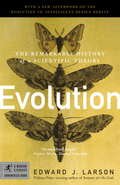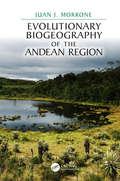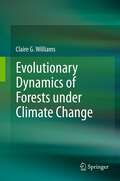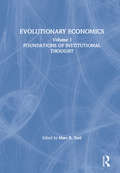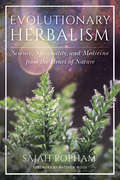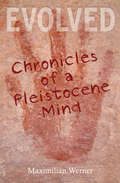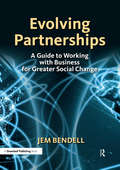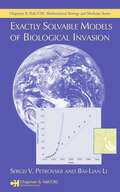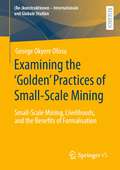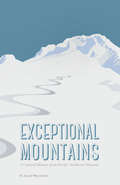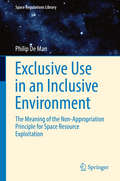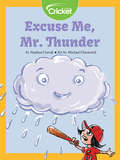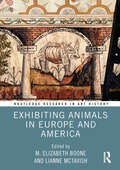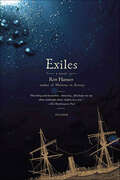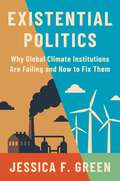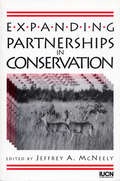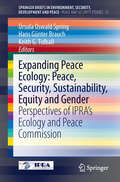- Table View
- List View
Evolution: The Remarkable History of a Scientific Theory (Modern Library Chronicles)
by Edward J. Larson"I often said before starting, that I had no doubt I should frequently repent of the whole undertaking." So wrote Charles Darwin aboard The Beagle, bound for the Galapagos Islands and what would arguably become the greatest and most controversial discovery in scientific history. But the theory of evolution did not spring full-blown from the head of Darwin. Since the dawn of humanity, priests, philosophers, and scientists have debated the origin and development of life on earth, and with modern science, that debate shifted into high gear.In this lively, deeply erudite work, Pulitzer Prize-winning science historian Edward J. Larson takes us on a guided tour of Darwin's "dangerous idea," from its theoretical antecedents in the early nineteenth century to the brilliant breakthroughs of Darwin and Wallace, to Watson and Crick's stunning discovery of the DNA double helix, and to the triumphant neo-Darwinian synthesis and rising sociobiology today.Along the way, Larson expertly places the scientific upheaval of evolution in cultural perspective: the social and philosophical earthquake that was the French Revolution; the development, in England, of a laissez-faire capitalism in tune with a Darwinian ethos of "survival of the fittest"; the emergence of Social Darwinism and the dark science of eugenics against a backdrop of industrial revolution; the American Christian backlash against evolutionism that culminated in the famous Scopes trial; and on to today's world, where religious fundamentalists litigate for the right to teach "creation science" alongside evolution in U.S. public schools, even as the theory itself continues to evolve in new and surprising directions.Throughout, Larson trains his spotlight on the lives and careers of the scientists, explorers, and eccentrics whose collaborations and competitions have driven the theory of evolution forward. Here are portraits of Cuvier, Lamarck, Darwin, Wallace, Haeckel, Galton, Huxley, Mendel, Morgan, Fisher, Dobzhansky, Watson and Crick, W. D. Hamilton, E. O. Wilson, and many others. Celebrated as one of mankind's crowning scientific achievements and reviled as a threat to our deepest values, the theory of evolution has utterly transformed our view of life, religion, origins, and the theory itself, and remains controversial, especially in the United States (where 90% of adults do not subscribe to the full Darwinian vision). Replete with fresh material and new insights, Evolution will educate and inform while taking readers on a fascinating journey of discovery.From the Hardcover edition.
Evolutionary Biogeography of the Andean Region (CRC Biogeography Series)
by Juan J. MorroneKey features: The first reference book to provide a comprehensive treatment of the biogreography of the Andean region Includes lists of the synonyms for each area and examples of the plant and animal taxa characterizing them. An extensive reference section serves as an entry point for more in-depth research on individual subjects Discusses the relationships between the areas, formulating hypotheses explaining the relationships of different biotas, based on track and cladistic biogeographic analyses Identifies cenocrons that were assembled in the different biotas Contains maps that illustrate the distribution of particular taxa, area cladograms and vegetation profiles This book presents a regionalization of the Andean region, based on an evolutionary biogeographic approach. Aimed at anyone wishing to understand biogeographic patterns of distribution of Andean plants and animals, the book provides a comprehensive treatment of three subregions, one transition zone, and 16 provinces. Lists of the synonyms and examples of taxa characterizing each area are given, and the relationships between the areas discussed, alongside hypotheses explaining the assembly of different biotas. Several maps illustrate the distribution of particular taxa, as well as area cladograms, diagrams and full-color vegetation profiles.
Evolutionary Dynamics of Forests under Climate Change
by Claire G. WilliamsFocusing on the example of the Lost Pines forest of Texas, this book contextualises the present-day conservation of the Lost Pines within its wealth of historical and geological records. This in turn presents a realistic example for examining evolutionary dynamics models and how they can guide management of temperate pine forests under the uncertainty of future climate change. Synthesising knowledge from many scholarly disciplines, and presenting the latest knowledge on how temperate forests respond to climate change, the book provides insight into how resource professionals actually solve complex multi-layered problems. A useful aid for forest management professionals and for advanced students and professionals in ecology, the book is a valuable resource for researchers and professionals, which can also be used as a classroom exercise for spatial imaging, testing virtual simulations and developing field-based research questions.
Evolutionary Ecology of Amphibians
by Gregorio Moreno-Rueda Mar ComasAmphibians are the oldest tetrapod group and show an astonishing diversity in lifestyles, many of them being unique. However, globally, they are on a decline. Hence, their study is fundamental to understanding the evolution of diversity and conserving them. This book, authored by experts from around the world, summarizes the current knowledge on the evolutionary ecology of amphibians. The book treats biological concepts related to the evolution, ecology, physiology, immunology, behaviour, and morphology of amphibians in their different states. This book constitutes an actualized work indispensable for evolutionary ecologists and herpetologists.
Evolutionary Economics: v. 1
by Marc R. ToolThe contributors to this volume focus on the political and value issues that, in their shared view, underlie the global environmental crisis facing us today. They argue that only by transforming our dominant values, social institutions and way of living can we avoid ecological disaster.
Evolutionary Herbalism: Science, Spirituality, and Medicine from the Heart of Nature
by Sajah PophamWeaving together herbal and medical traditions from around the world into a singular cohesive model, this groundbreaking book guides herbal practitioners to a comprehensive understanding of the practice and philosophy of healing with herbs.Written by a rising star in the field, Evolutionary Herbalism presents a wide-angled and innovative approach to herbalism that considers both the plant and the human in a holistic context. Sajah Popham teaches a method of heart-centered contemplation that allows practitioners to access and honor the psychological, emotional, physiological, and spiritual qualities of a plant, resulting in a transformative level of healing. Organized in five parts that lead the reader from the microcosmic to the universal, this work encompasses Ayurveda, alchemy, Chinese medicine, astrology, and clinical herbalism to address physical and spiritual levels of well-being. For both the student herbalist and the experienced practitioner, as well as a readers interested more generally in ecology and spirituality, Popham's teachings guide readers to a more intimate, synergistic, and intuitive relationship with the plant kingdom.
Evolutionary History
by Edmund RussellWe tend to see history and evolution springing from separate roots, one grounded in the human world and the other in the natural world. Human beings have, however, become probably the most powerful species shaping evolution today, and human-caused evolution in other species has probably been the most important force shaping human history. This book introduces readers to evolutionary history, a new field that unites history and biology to create a fuller understanding of the past than either can produce on its own. Evolutionary history can stimulate surprising new hypotheses for any field of history and evolutionary biology. How many art historians would have guessed that sculpture encouraged the evolution of tuskless elephants? How many biologists would have predicted that human poverty would accelerate animal evolution? How many military historians would have suspected that plant evolution would convert a counter-insurgency strategy into a rebel subsidy? With examples from around the globe, this book will help readers see the broadest patterns of history and the details of their own life in a new light.
Evolutionary Paleoecology: The Ecological Context of Macroevolutionary Change
by David J. Bottjer Warren AllmonOne of the most important questions we can ask about life is "Does ecology matter?" Most biologists and paleontologists are trained to answer "yes," but the exact mechanisms by which ecology matters in the context of patterns that play out over millions of years have never been entirely clear. This book examines these mechanisms and looks at how ancient environments affected evolution, focusing on long-term macroevolutionary changes as seen in the fossil record. Evolutionary paleoecology is not a new discipline. Beginning with Darwin, researchers have attempted to understand how the environment has affected evolutionary history. But as we learn more about these patterns, the search for a new synthetic view of the evolutionary process that integrates species evolution, ecology, and mass extinctions becomes ever more pressing. The present volume is a benchmark sampler of active research in this ever more active field.P.K. Strother, Choice
Evolved
by Maximilian Werner John AlcockFrom which side of the bed you sleep on to where to play a backyard game of hide-and-go-seek, Maximilian Werner examines elements of everyday behavior through the eye-opening lens of evolutionary theory in this memoir-infused nonfiction. Werner applies an intriguingly fresh take to seldom-explored habits of humans and animals alike, guiding readers backward in time to the Pleistocene."Werner's prose is compelling, his natural history is thoroughly engaging, and his line of curious inquiry is an admirable attempt to better understand humanity and its changing relationship with the external world."-Publishers Weekly"This book provides an entry in to the great epic of evolution in a way that makes it both accessible and inspiring. This is no small accomplishment and we are all indebted to Maximilian Werner."-Mary Evelyn Tucker, co- author, Journey of the Universe"Join this sensitive and perceptive naturalist as he explores his yard and nearby caves and mountains, carefully observing the activities of myriad life forms, and then reflecting insightfully on the evolutionary story we share with them. Learn from him how to feel completely at home in the world."-Loyal Rue, author of Religion is Not about God: How Spiritual Traditions Nurture Our Biological Nature and What to Expect When They Fail"Werner's book, thought-provoking and emotionally satisfying, takes us on a journey, a journey that ultimately urges each one of us to get up, go outside and hunt around the edges of our homes for the mysteries that await."-Sylvia Torti, author of The Scorpion's Tail
Evolving Partnerships: A Guide to Working with Business for Greater Social Change
by Jem BendellBy bringing together their respective competencies and resources for the greater good, governments, business, civil society and multilateral agencies have been seeking innovative ways to work together to respond to the myriad global challenges of our time: the impact of climate change; human security; the prevention, care and treatment of HIV/AIDS and other major diseases; the generation of new investment, entrepreneurship and employment; and financing for development. The appetite for such partnerships appears strong. Over 90% of corporate executives responding to a World Economic Forum survey felt that future partnerships between business, government and civil society would play either a major role or some role in addressing key development challenges. This trend will only be increased by the Western financial crisis and the retreat of the state from many areas of societal concern. In the last 15 years, many new partnerships have been formed, and many new people exposed to partnership ways of working. There have been remarkable successes, but also a range of concerns about effectiveness and accountability. Partnerships can work, but can they work better? Many practitioners are now asking how they can achieve a greater scale of impact to match the magnitude of the social and environmental challenges we face. When considering how to equip their organization or programme with the necessary skills to engage with companies in new ways, many leaders of NGOs or UN agencies hire staff from the private sector. Although such staff exchanges are important, it is not sufficient to rely on private-sector staff to develop and implement strategic forms of engagement. Rather, engaging business for social change is a specialism in itself. This book seeks to distil some of the author's 15 years of experience and key learnings on the advanced strategic planning of partnerships for people who work within civil society or public-sector organizations and who already partner with companies. Much of the research focus to date has been on operational issues, rather than on the strategic challenge of evolving partnerships to achieve a greater scale of impact. Rather than helping the reader with moving on from partnerships, this guidebook is intended to help with moving up to a greater scale of impact. The author identifies three generations in the evolution of cross-sector partnering and draws insights from the latest biological evolutionary theory on how complex systems can sustain themselves over time, translating this into a method for understanding and assessing partnering practice. Evolving Partnerships provides a rich and accessible mix of commentary, boxes for clarification, and 11 exercises to help the reader evolve partnering to achieve a wider level of impact – a level that responds to the scale, depth and urgency of the challenges we face today. Written by one of the world's leading authorities on partnerships and a key architect of global partnerships, including the Marine Stewardship Council, Evolving Partnerships will be essential reading for all those involved in cross-sectoral partnerships.
Ex Situ Plant Conservation: Supporting Species Survival In The Wild (Science Practice Ecological Restoration #3)
by Peter H. Raven Kayri Havens Center for Plant Conservation Edward O. Guerrant Michael MaunderFaced with widespread and devastating loss of biodiversity in wild habitats, scientists have developed innovative strategies for studying and protecting targeted plant and animal species in "off-site" facilities such as botanic gardens and zoos. Such ex situ work is an increasingly important component of conservation and restoration efforts. Ex Situ Plant Conservation, edited by Edward O. Guerrant Jr., Kayri Havens, and Mike Maunder, is the first book to address integrated plant conservation strategies and to examine the scientific, technical, and strategic bases of the ex situ approach. The book examines where and how ex situ investment can best support in situ conservation. Ex Situ Plant Conservation outlines the role, value, and limits of ex situ conservation as well as updating best management practices for the field, and is an invaluable resource for plant conservation practitioners at botanic gardens, zoos, and other conservation organizations; students and faculty in conservation biology and related fields; managers of protected areas and other public and private lands; and policymakers and members of the international community concerned with species conservation.
Exactly Solvable Models of Biological Invasion (Chapman & Hall/CRC Mathematical Biology Series)
by Sergei V. Petrovskii Bai-Lian LiMuch of our current knowledge on biological invasion was derived from field studies, but many recent advances relied heavily on mathematics and computing, particularly mathematical modeling. While numerical simulations are clearly a useful approach, they have some serious drawbacks. Approximations errors and the number of parameter values can have
Examining the ‘Golden’ Practices of Small-Scale Mining: Small-Scale Mining, Livelihoods, and the Benefits of Formalisation ((Re-)konstruktionen - Internationale und Globale Studien)
by George Okyere OfosuScholarship on artisanal and small-scale mining (ASM) has often portrayed mining regions as ‘informal’ zones that suffer from environmental degradation problems. Water pollution and degraded landscapes, for example, have long been noted as the inevitable consequence of the operations of ASM. Such insistence on the institutional absences of ASM zones has dovetailed with a lack of academic attention to some of the ‘golden’ mining practices taking place there. Thus, this work seeks to (re)examine the topic of ‘development’ in ASM. The findings suggest that small-scale miners, contrary to popular perception, could be caretakers of the environment. In addition, emphasizing how the dynamic interplay between resources and environmental demands may come to support public policy, the findings illustrate, contrary to the dominant narrative, how the activities of small-scale mining operators can engender a win-win situation for both mining companies and local mining communities.
Exceptional Mountains: A Cultural History of the Pacific Northwest Volcanoes
by O. Alan WeltzienOver the past 150 years, people have flocked to the Pacific Northwest in increasing numbers, in part due to the region’s beauty and one of its most exceptional features: volcanoes. This segment of the Pacific Ring of Fire has shaped not only the physical landscape of the region but also the psychological landscape, and with it the narratives we compose about ourselves. Exceptional Mountains is a cultural history of the Northwest volcanoes and the environmental impact of outdoor recreation in this region. It probes the relationship between these volcanoes and regional identity, particularly in the era of mass mountaineering and population growth in the Northwest. O. Alan Weltzien demonstrates how mountaineering is but one conspicuous example of the outdoor recreation industry’s unrestricted and problematic growth. He explores the implications of our assumptions that there are no limits to our outdoor recreation habits and that access to the highest mountains should include amenities for affluent consumers. Each chapter probes the mountain-based regional ethos and the concomitant sense of privilege and entitlement from different vantages to illuminate the consumerist mind-set as a reductive—and deeply problematic—version of experience and identity in and around some of the nation’s most striking mountains.
Exclusive Use in an Inclusive Environment
by Philip De ManThis book aims to find a workable interpretation of the non-appropriation principle that is compatible with both the existing international space law framework and the move of the private space industry towards the mining of asteroids and other celestial bodies. It does so by analysing the rules on the use of orbits as limited natural resources as a concrete indication of how space resources can be exploited by one user while respecting the non-appropriation principle and the interests of other users in space. This analysis is complemented by a thorough review of the meaning of property rights in the context of the existing international space law regime. This allows the author to distinguish between the lawful exploitation and unlawful appropriation of resources in a manner that could pave the way for a workable asteroid mining regime that takes into account the needs of individual companies and the international community. Exclusive use in an inclusive environment frames the legal regime of the exploitation of natural resources in outer space as the most pressing example to date of the tension that arises between the rights of a single spacefaring actor and the interests of the broader international community. Though academic in its approach in dealing with one of the most fundamental issues of space law to date, the book has very practical ambitions. By offering a pragmatic interpretation of the space law principles that are likely to remain the legal foundations of asteroid mining for the foreseeable future, Exclusive use in an inclusive environment hopes to inform academics, practitioners and policymakers alike in their future attempts at working out a fair, equitable and effective management regime for the exploitation of natural resources in outer space.
Excuse Me, Mr. Thunder
by Stephen CravakAlly needs to rest up for the big game tomorrow, but she is awakened first by the wind, then the rain, and finally thunder. She politely asks them to leave, which they do, until game time.
Exhibiting Animals in Europe and America (Routledge Research in Art History)
by M. Elizabeth Boone Lianne McTavishThis edited volume, written by historians of art and visual culture who are working in the field of animal studies, seeks to understand how our ways of positioning (and ex-positioning) animals have separated us from the other-than-human animals that are an integral part of our interconnected world.Bringing together the visual and material culture of display with recent theoretical study on human–animal relations, the book draws attention to ways in which we might rethink this history and map pathways for the future. Defining the idea of exhibition and display broadly, chapters consider a diverse range of media, including paintings, anatomical sculpture, books, prints, and clothing; exhibition venues that take place in both the public and private realms; and key ideas such as looking at/looking back, seeing/being seen, and interspecies recognition. The authors cover topics that span the sixteenth through the early twentieth centuries and focus geographically on Europe and America, with significant content related to Canada, Indigenous America, and Latin America.The book will be of interest to scholars working in art history, visual studies, museum studies, animal studies, and environmental humanities.
Exile And Pride: Disability, Queerness and Liberation
by Eli ClareExile and Pride is a call to awareness, an exhortation for each of us to examine our connection to and alienation from our environment, our sexuality, and each other.
Exiles: A Novel
by Ron HansenWith Exiles, Ron Hansen tells the story of a notorious shipwreck that prompted Gerard Manley Hopkins to break years of "elected silence" with an outpouring of dazzling poetry. In December 1875 the steamship Deutschland left Bremen, bound for England and then America. On board were five young nuns who, exiled by Bismarck's laws against Catholic religious orders, were going to begin their lives anew in Missouri. Early one morning, the ship ran aground in the Thames and more than sixty lives were lost—including those of the five nuns. Hopkins was a Jesuit seminarian in Wales, and he was so moved by the news of the shipwreck that he wrote a grand poem about it, his first serious work since abandoning a literary career at Oxford to become a priest. He too would die young, an exile from the literary world. But as Hansen's gorgeously written account of Hopkins's life makes clear, he fulfilled his calling. Combining a thrilling tragedy at sea with the seeming shipwreck of Hopkins's own life, Exiles joins Hansen's Mariette in Ecstasy (called "an astonishingly deft and provocative novel" by The New York Times) as a novel that dramatizes the passionate inner search of religious life and makes it accessible to us in the way that only great art can.
Existential Politics: Why Global Climate Institutions Are Failing and How to Fix Them
by Jessica F. GreenA new way to tackle the real politics of climate change through asset revaluationIt&’s no secret that the Paris Agreement and voluntary efforts to address climate change are failing. Governments have spent three decades crafting international rules to manage the climate crisis yet have made little progress on decarbonization. In Existential Politics, Jessica Green explains why this is unsurprising: governments have misdiagnosed the political problem of climate change, focusing relentlessly on measuring, reporting, and trading emissions. This technical approach of &“managing tons&” ignores the ways that climate change and climate policy will revalue assets, creating winners and losers. Policies such as net zero, carbon pricing, and offsets all cater to the losers—owners of fossil assets.Ultimately, Green contends, climate change is a political problem. Climate politics should be understood as existential—creating conflicts that arise when some actors face the prospect of the devaluation or elimination of their assets or competition from the creation of new ones. Fossil asset owners, such as oil and gas companies and electric utilities, stand to lose trillions in the energy transition. Thus, they are fighting to slow decarbonization and preserve the value of their assets. Green asset owners, who will be the basis of the decarbonized economy, are fewer in number and relatively weak politically.Green proposes using international tax, finance, and trade institutions to create new green asset owners and constrain fossil asset owners, reducing their clout. Domestic investments in green assets, facilitated by global trade rules, can build the political power of green asset owners.
Exotic Amphibians and Reptiles of the United States
by Walter E. Meshaka Jr. Suzanne L. Collins R. Bruce Bury Malcolm L. McCallumThe first complete field guide to the exotic amphibians and reptiles established in the continental United States and Hawaiʻi, this volume covers 74 species that are not native to the country and 29 species that are native but occur beyond their original geographic range. Dispersed from their former habitats by human activity, many of these species are invasive in their new environments, causing ecological or economic harm. Ideal for naturalists of all levels, Exotic Amphibians and Reptiles of the United States details each species’ taxonomy, distribution, history, and ecology and portrays each one with vibrant photographs. Drawing on county-level distribution maps from 2,908 published records, this guide provides an in-depth understanding of local factors that drive the success of exotic species. It connects species-specific information to conservation issues as it explores human causes of exotic and invasive establishment. The book also includes eight invited essays which provide regional perspectives on scientific, economic, and management-related aspects of this phenomenon. As ecological pressures on native species and habitats increase, understanding the histories and roles of exotic species is becoming more and more important for conservation efforts. Providing practical identification skills and an awareness of the environmental impacts of these amphibians and reptiles, this indispensable guide equips readers to confront the unusual biodiversity crisis of exotic species.
Expanded Nature: Écologies du cinéma expérimental (Experimental Film and Artists’ Moving Image)
by Elio Della Noce Lucas MurariThis book explores the emergence of ecological consciousness in the work of contemporary experimental filmmakers. If it can be said that experimental filmmakers are "expanding" the artistic field through an exploration of the potencies, modes of dissemination and performance of the moving image, in the Anthropocene these practices strive for another kind of expansion: to expand our experience of nature. Appending flowers to the film strip or burying it in the ground, inventing observational devices, allowing the camera to be affected by natural forces, engaging one's own filming body in a symbiotic relationship with the environment, reconstituting ecosystems at the moment of projection: the ecologies of experimental cinema presented in this book constitute forms of practice and engagement that awaken a heightened sensibility towards the living world through cooperative links, casting other beings as subjects and agents of filmic processes, and, finally, reshaping the economy of filmmaking. Thus, ecologies of perception, medium, production, and multinaturalism are deployed, contributing to the restoration of our sensory bond with the natural world. Several chapters were translated with the help of artificial intelligence. In each case, the text has subsequently been revised further by the author as well as the translator Charlie Hewison and a professional copy editor.
Expanding Partnerships in Conservation: Science, Trends, And The Challenge Of Sustainability
by Jeffrey A. McneelyProtected areas around the globe national parks, wildlife reserves, biosphere reserves will prosper only if they are supported by the public, the private sector, and the full range of government agencies. Yet such support is unlikely unless society appreciates the importance of protected areas to its own interest, and the protected areas are well-managed and contribute to the national welfare in a cost-effective way.A crucial foundation for success is full cooperation between individuals and institutions. Based on papers presented at the IVth World Congress on National Parks and Protected Areas, Expanding Partnerships in Conservation explores how new and stronger partnerships can be formed between managers of protected areas and other sectors of society. It describes a range of activities currently underway in many parts of the world that are intended to improve conservation efforts at the international, national, and local levels.
Expanding Peace Ecology: Peace, Security, Sustainability, Equity and Gender
by Keith G. Tidball Úrsula Oswald Spring Hans Günter BrauchThis book has peer-reviewed chapters by scholars from Australia, Canada, Germany, Japan, Mexico and the USA that were presented to the Ecology and Peace Commission (EPC) of the International Peace Research Association (IPRA) in November 2012 in Japan. The chapters address these themes: Expanding Peace Ecology - Peace, Security, Sustainability, Equity and Gender; Two Discourses on Global Climate Change Impacts: From Climate Change and Security to Sustainability Transition; Peace Research and Greening in the Red Zone: Community-based Ecological Restoration to Enhance Resilience and Transitions Toward Peace; Social and Environmental Vulnerability in a River Basin of Mexico; Mobile Learning, Rebuilding Community Through Building Communities, Supporting Community Capacities: Post Natural Disaster Experience; Transforming Consciousness through Peace Environmental Education; Building Peace by Rebuilding Community; Ability Expectations and Peace and on Satoyama Sustainability and Peace.
Expedition Deep Ocean: The First Descent to the Bottom of All Five Oceans
by Josh YoungThe riveting story of the exploration of the final frontier of our planet—the deep ocean—and history-making mission to reach the bottom of all five seas.Humankind has explored every continent on earth, climbed its tallest mountains, and gone into space. But the largest areas of our planet remain largely a mystery: the deep oceans. At over 36,000 feet deep, there areas closest to earth&’s core have remained nearly impossible to reach—until now. Technological innovations, engineering breakthroughs and the derring-do of a team of explorers, led by explorer Victor Vescovo, brought together an audacious global quest to dive to the deepest points of all five oceans for the first time in history. The expedition pushed technology to the limits, mapped hidden landscapes, discover previously unknown life forms and began to piece together how life in the deep oceans effects our planet—but it was far from easy. Expedition Deep Ocean is the inside story of this exploration of one of the most unforgiving and mysterious places on our planet, including the site of the Titanic wreck and the little-understood Hadal Zone. Vescovo and his team would design the most advanced deep-diving submersible ever built, where the pressure on the sub is 8 tons per square inch—the equivalent of having 292 fueled and fully loaded 747s stacked on top of it. And then there were hurricane-laden ocean waters and the byzantine web of global oceanography politics. Expedition Deep Ocean reveals the marvelous and other-worldly life found in all five deep ocean trenches, including several new species that have posed as of yet unanswered questions about survival and migration from ocean to ocean. Then there are the newly discovered sea mounts that cause tsunamis when they are broken by shifting subduction plates and jammed back into the earth crust, something that can now be studied to predict future disasters. Filled with high drama, adventure and the thrill of discovery, Expedition Deep Ocean celebrates courage and ingenuity and reveals the majesty and meaning of the deep ocean.
